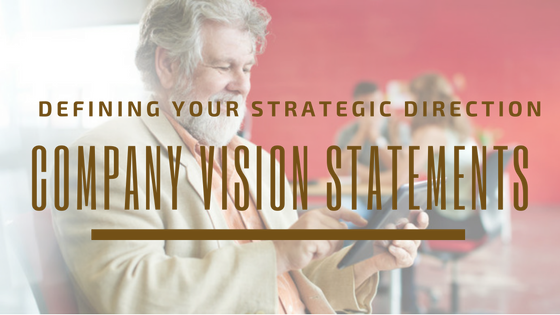What is a Company Vision Statement?
There are many different definitions for a company vision statement, but they all lead to the same outcome. The business dictionary defines a vision statement as “an aspirational description of what an organization would like to accomplish in the mid- or long-term future. It is intended to serve as a clear guide for choosing current and future courses of action.”
A strong vision statement clearly communicates the overall goals for the business, and can serve as the focal point of strategic decision-making throughout the company. This is an essential part of strategic management. Without strategic objectives in place, the company will not be able to create an operational plan that can be correctly implemented, monitored and evaluated. This sets the standard for management and employees. Without a clear vision in place, there is nothing to align with, and customers, vendors and shareholders will not have a starting point in what to expect from the organization.
Why Company Vision Statements Matter
Company vision statements add clarity to your goals and objectives. They provide your organization with a strategic direction and assist employees in understanding where the company is going. Consider them blueprints that clearly outline the long-term goals and provide a snapshot of what the company should look like when it gets there. It also assists managers in their singular goals, giving them a chance to set strategic objectives and plans that align with the company’s vison.
A company vision statement also gives the organization a purpose. Research shows that employees who see the vision statement as a meaningful motivator have engagement levels of 68%. It helps motivate employees to collaboratively work to improve work conditions so the purpose can be achieved, productivity will be enhanced, and turnover will be reduced.
When employees are connected to the company in both head and heart, they are willing to go the extra mile in getting the job done. When employees are not engaged, the company is encouraging missed business opportunities. There are numerous advantages on selling your employees on the company’s future and their role in it. In the words of CV Harquail, “People are more likely to generate their own ideas, to contribute with enthusiasm, to keep slogging when it becomes unpleasant, and also to experience a sense of camaraderie and togetherness.”
Also see: 4 signs that your small business needs a business coach
How to Build Your Company Vision Statement
In order to write a strong vision statement, you must define where you are going. The vision statement defines where your company is going, not where you currently are.
-
Create a Timeline
Use a 10-year window of where you want the company to be, and start there. This gives management time to assess their processes, set goals and objectives, employ the right people and work together in getting there.
-
Keep It Clear
Focus on the message. The key is to keep it simple. You want a vision statement that is clear, concise, and gets people engaged. The vision means nothing if the people who are charged with moving the company forward do not understand or believe in it.
-
Define Your Obstacles
Define any obstacles that may get in the way of achieving the vision. Detail whether these are internal and external, and develop an action plan for overcoming these obstacles. Be strategic in your thinking – who are your competitors? What types of technology should your organization be using? Are your systems on par with the trends? Do you need a total revamp?
-
Communicate Your Vision
Everyone on the team should be in agreement with the vision statement. As every member of your organization will be impacted whether or not the vision is achieved, they should all have a vested interest in its success. Do not make the vision out of reach – it should be reasonable, and most of all attainable. Employees want something to look forward to. Keep the vision and employees in touch.
Knowing what your core values are when you begin will give you an idea of what you want your business to look like – image is everything, both internally and externally. You should have a good balance within your organization with diversity and most of all, accountability. Your underlying philosophies also play a role in how your company operates, and the vision you will create to move into the future. Consider your personal key values, the key values of management, and the key values of your employees. Are they cohesive? Additionally, you should be able to identify and test the level of commitment you have to your organization. If you personally aren’t committed, then you can’t really expect anyone working for you to be either. One of your main goals should be to have a quick, effective environment where you inspire leadership.
Building a company vision can be difficult, even for those CEOs who have been in the business for many years. Understanding and defining a company’s vision can pose great challenges. There are frameworks that can assist in providing clarity to clearly define where you are trying to go. The EOS system is a tool that works to provide results in a simple format. It helps you achieve three things: vision, traction, and a healthy team – all components of organizational success.
A business coach shows you how to operate at maximum efficiency. You can find out more with our free guide that explains how to grow a successful business to help you take the steps you need to get your company in order and create a vision statement that will resonate with management and all of your employees. For more information, contact me to schedule a business coaching consultation today!
Related Articles:
- 5 Steps to building your company vision
- How to develop your company’s future leaders
- Coach your employees to greatness
The Entrepreneurial Operating System (EOS) was created by Gino Wickman (Author of Traction-get a grip on your business) and is a registered trademark of EOS Worlwide. Chris Hallberg of Traction Inc. is a Certified EOS Implementer(tm) that helps business owners and their leadership teams get more of what they want from their business.



